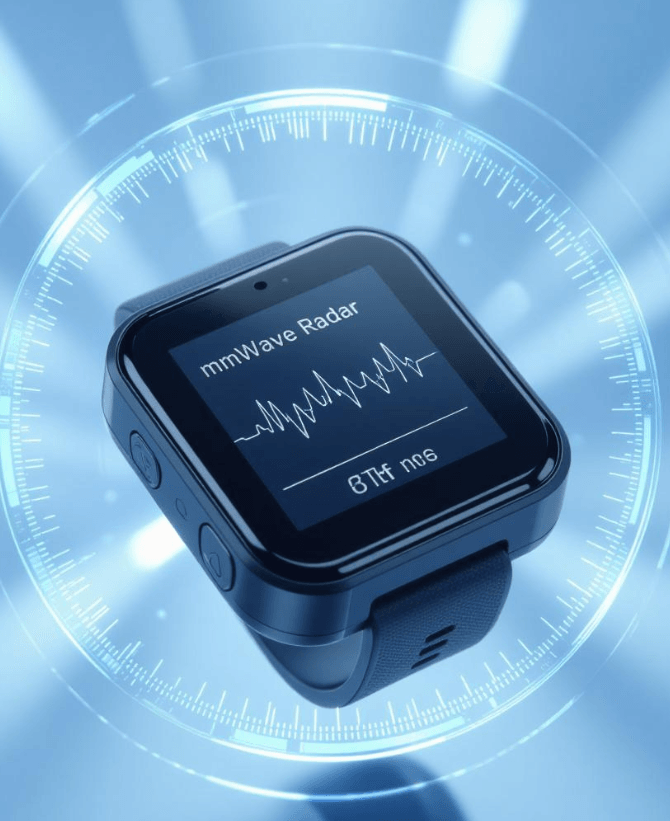Author: Andy Credentials: Possessing over 10 years of experience in sensor technology research and development, specializing in digital health and remote monitoring solutions.
In the ever-evolving landscape of wearable medical devices, recent market analyses confirm a seismic shift from basic fitness tracking to sophisticated health monitoring systems. The global market is projected for significant growth in the coming decade, driven by advancements in sensor technology, AI integration, and the rising demand for remote patient monitoring. Amid the buzz of smartwatches and glucose monitors, one technology is quietly emerging as a game-changer: millimeter wave (mmWave) radar sensors. These non-contact sensors are transforming how we detect vital signs, offering precise, real-time insights without the need for physical contact. Industry discussions highlight that the true value lies in turning raw health data into actionable, life-saving healthcare decisions. Let's dive into how mmWave radar is poised to elevate this sector.
1. What Are Millimeter Wave Radar Sensors and Why Non-Contact?
Millimeter wave radar operates in the frequency range of 30-300 GHz (Extremely High Frequency, EHF), utilizing short-wavelength electromagnetic waves to detect motion and micro-movements with exceptional accuracy. A key advantage of mmWave radar is its penetration capability. Unlike traditional optical (PPG) or infrared sensors, which are highly susceptible to interference from lighting, sweat, or clothing, mmWave radar can effectively measure through materials and functions consistently across various environments, making it uniquely ideal for continuous medical applications.
In the context of wearables, these sensors capture subtle, involuntary body movements—such as minute chest expansions for respiration or tiny surface displacements caused by arterial pulses for heart rate—all without requiring direct skin contact.
While this technology is already mature in industries like automotive (for collision avoidance) and security (for gesture recognition), its adaptation to healthcare is accelerating. MmWave radars can extract vital signs by analyzing micro-motions on the body surface, providing a robust, non-invasive alternative to traditional electrodes or cuffs. This capability perfectly aligns with the industry's trend toward multi-parameter monitoring devices.
2. Integration in Wearable Medical Devices: Trends and Innovations
The wearable medical devices market is experiencing significant growth, with a strong focus on integrating AI and machine learning to make sense of the vast amounts of generated data. MmWave radar is a natural fit for this ecosystem. Companies are actively exploring it for hygienic, non-contact health monitoring, a need that was greatly accelerated by the shift toward remote care solutions.
-
Industry Examples: Publicly available patents, such as those filed by major technology firms (e.g., Apple), indicate a strong interest in using radar-based biometric monitoring in future wearables. These systems use mmWave signals to detect micro-movements for vital sign and potential heart rhythm analysis.
-
Clinical Research: Academic and corporate research has demonstrated the potential of mmWave systems, often leveraging machine learning algorithms, to accurately perform tasks like arrhythmia detection and continuous vital signs extraction. The sensors are also being explored for non-invasive detection of skin temperature changes and arterial pulse wave characteristics in wearable form factors, prioritizing user comfort.
-
Targeted Growth Areas: The cardiovascular monitoring segment remains a primary growth driver in the industry. Non-invasive heart rate monitoring via mmWave can reduce the frequency of hospital visits for patients with chronic conditions, supporting the market's focus on preventive healthcare models.
-
Elderly and Remote Care: Beyond vital signs, advanced mmWave systems are being developed for activity monitoring in telemedicine, enabling reliable classification of patient actions like walking, sleeping, or critical fall detection. The low-power and small form factor of these sensors are crucial for extending device life, addressing a key logistical challenge in remote elderly care.
3. Challenges and Opportunities Ahead: The Road to Clinical Trust
Like all new technologies, mmWave radar integration faces hurdles. General challenges in the wearables sector, such as data privacy, ensuring data accuracy across diverse populations, and achieving seamless interoperability between devices, also apply here.
-
Accuracy and Regulation: For mmWave radar, the primary technical challenge is ensuring medical-grade precision and reliability across various body types and environments. Regulatory bodies, such as the FDA in the U.S., are continuously developing pathways for the approval of these non-contact, software-driven digital health tools, requiring robust clinical validation.
-
Logistics and Cost: Achieving cost-effective manufacturing and ensuring straightforward integration with existing clinical infrastructures and electronic health records (EHRs) are critical prerequisites for widespread adoption.
Despite these challenges, the opportunities remain vast. As AI processing moves to the edge, mmWave data can be processed in real-time to provide truly predictive insights, turning wearables into proactive health guardians. Further research is exploring the non-invasive detection of subtle biosignals and biomarkers, promising to revolutionize diagnostics for conditions ranging from cardiovascular issues to neurological events and post-surgical recovery monitoring.
4. Looking Forward: A Contactless Future Defined by Precision
Fueled by significant investment in technology and a shift toward value-based care models, non-contact mmWave radar sensors are poised to become a core component of next-generation wearables. They embody the convergence of technology and healthcare, resulting in devices that are more comfortable, more accurate, and seamlessly integrated with AI-driven monitoring ecosystems. For chronic disease management or general wellness, this technology promises to make health monitoring effortless yet clinically precise.
If you're tracking the healthcare technology space, these developments warrant close attention—they are shaping a future where health monitoring moves from reactive tracking to proactive intervention.
What are your thoughts on mmWave in wearables? Share your views on its biggest challenge or most exciting opportunity below!
FAQ: Common Questions About Millimeter Wave Radar Sensors in Wearables
Q1: What makes mmWave radar sensors different from traditional sensors in wearables?
A: Traditional sensors (like optical PPG) often require direct skin contact and are easily affected by environmental factors (e.g., light, sweat). MmWave radar uses high-frequency electromagnetic waves to detect micro-movements non-invasively, penetrating clothing and working in various conditions for more reliable, continuous vital sign monitoring.
Q2: How accurate are mmWave radar sensors for medical applications?
A: When properly calibrated and combined with advanced signal processing, mmWave sensors offer very high accuracy for detecting heart rate, respiration, and other vital signs, often comparable to established medical-grade equipment in laboratory settings. Accuracy in real-world wearable scenarios is the subject of ongoing research and clinical trials necessary for regulatory approval.
Q3: Are there privacy concerns with mmWave radar in wearable devices?
A: Yes, continuous data collection inherent to these devices raises privacy issues. Manufacturers must address this through robust data encryption, user consent features, and compliance with strict health data regulations (like HIPAA/GDPR). On-device processing (Edge Computing) is a key strategy to enhance user privacy by minimizing data transmission.
Q4: Which companies are leading in mmWave radar integration for medical wearables?
A: Leading innovators include semiconductor firms that produce the core radar chips, specialized sensor module manufacturers like LINPOWAVE, and large consumer electronics and healthcare companies that are investing heavily in its application through patents and R&D.
Q5: What is the battery impact of mmWave radar in wearables?
A: MmWave sensors are generally designed to be low-power. Their low-duty cycle and efficient signal processing mean they typically consume less energy than continuous video or high-frequency optical imaging systems, which helps extend the overall battery life of wearable devices.



